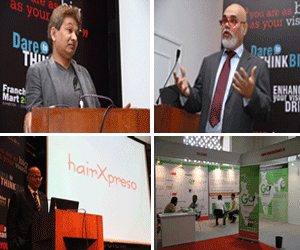As demand for industrial and service robots increase, teaching various aspects of robotics can be the new buzz word.
As technology becomes increasingly more important in today’s world, it is extremely important not only to learn how to use technology, but also to understand how to create it. We believe young students should be exposed to hands-on math, science, and engineering and computer programming, at a young age. Robotics introduces young students to engineering and motivates them to be involved in creating future technology.
In addition, robotics allows young students to develop invaluable skills such as problem-solving, logical reasoning, critical thinking and creativity.
Understanding the concepts of programming is important for success in engineering but the application of software – the integration of logic and hardware is also imperative in the context of learning and skill for success in solving difficult problems.
Teaching software without hardware is like explaining the purpose of “the arc” without “the flood”. Robotics has a rich context for learning technology and it is a means to an end — a very cool hook on which to hang complex concepts. The scope for a career in robotics in India is tremendous and people can explore career opportunities in diversified sectors ranging from space research organizations to pure manufacturing companies.
Apart from automobile companies, which account for 70 percent of robotics applications in India, other sectors like foundry, food, logistics, healthcare and entertainment are also aggressively looking at adopting robots.
The cases in point are the two prominent industries of the SME sector – forging and diamond. Robots contribute substantially towards rationalizing cost-effective automation solutions in all areas of the forging industry. Whatever the application, be it loading and unloading of die- casting machines, deflashing presses or machining centres; spraying; finishing processes like milling, sawing and grinding, or handling hot, heavy forgings, these robots meet every need including applications in harsh ambient conditions. Trends suggest that internationally the diamond industry is moving towards very high precision workmanship. Robots play a critical role for this industry which is pegged at Rs. 60,000 crore.
Robots are also used in the field of nuclear science, sea-exploration, servicing of transmission electric signals, designing of bio-medical equipments etc. A candidate having an M.E. degree in robotics can get job opportunities in space research organizations like ISRO and also in industries which manufacture microchips.
Building a robot can be a time consuming affair, requiring hours of sawing, drilling, grinding, soldering, and programming. Many kids simply do not have the attention span to wait that long before seeing results, so for the typical child a ready-to-go kit is the best option. Ideally, the kit should include all the mechanical and electronic components to make a functional robot capable of at least rudimentary actions, such as reacting to light or following a black line on a white piece of paper. Fortunately, there are many such kits available, at most reasonable prices. The kits used for teaching robotics to children have been thoughtfully designed after long research works so that kids are neither hurt nor they encounter any difficulty in building their own robot. Programming of robots is also very simple to learn by the kids at this age because they absorb knowledge like a sponge soaks water.
While teaching robotics at the Harvard University, professors were amazed by the excitement the children showed while building robots in his class. Realizing how few educational outlets existed for children to learn robotics, they conceived the idea of creating a space, in which children could build robots,
and expand their math and science skills.
Robotics for Fun was established as a program that provides a learning environment for children in all aspects of robotics. Since we first opened our doors, children come to class excited and ready to learn. Parents literally have to pull them away from their projects at the end of the day.
In developed countries like USA, Germany and Japan, robotics is introduced in all the schools at nursery level and kids build their own working robot at the age of 5.
They participate in robotic Olympiads which are held nationally and internationally.
Entering the field of robotics can cost cores of rupees in hardware and software, the barrier to entry has been quite high. However, the software field is relatively cheaper and with the advent of open source concept, a newcomer to easily get started with very little initial cost by building upon software created by others. India has always been good when it comes to software and allowing young minds to toy with different software is also offering a new learning opportunity for those with an interest in robotics.
There are about 1.2 million industrial robots working worldwide — that’s one robot for every 5,000 people, according to Marshall Brain, founder of How Stuff Works and author of Robotic Nation. India is a vast country with lakhs of schools and over 230 million students are enrolled in government. and private schools across the country. Teaching robotics to kids and children is a new field in our country and at its nascent stage. As demand for robotics rise, the time is right for players to enter the niche field of robotic education. The future of robotic training institutes is extremely bright and lucrative in our country and one needs to ride this wave.































 +91 9909960054
+91 9909960054